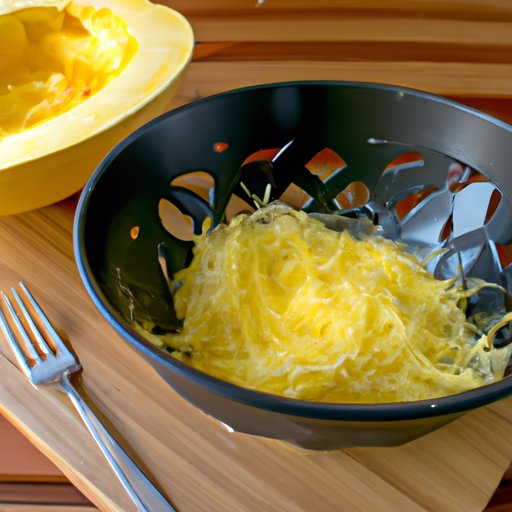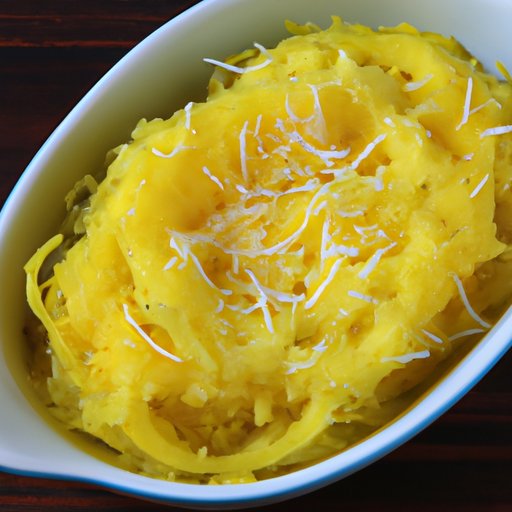
I. Introduction
Spaghetti squash has become increasingly popular in recent years, and for good reason. This tasty vegetable is an excellent alternative to traditional pasta, with a similar texture and flavor, and significantly more nutritional value. Whether you’re looking for a way to eat healthier, experiment with new ingredients, or simply try something new in the kitchen, spaghetti squash is a versatile and delicious option.
In this article, we will provide a step-by-step guide to cooking spaghetti squash, as well as tips and tricks for seasoning, serving, and incorporating it into a variety of dishes. We will also explore the nutritional benefits of this nutritious vegetable, and offer a selection of creative and easy-to-make recipes to inspire you in the kitchen.
II. Step-by-step instructions for cooking spaghetti squash in the oven
One of the most common methods for cooking spaghetti squash is in the oven. This is a simple and reliable method for achieving a delicious result, and allows for easy seasoning and customization. Follow these steps for perfect spaghetti squash every time:
1. Preheating the oven
Preheat your oven to 375-degrees Fahrenheit.
2. Cutting the squash
Cut the spaghetti squash in half lengthwise, using a sharp knife. Be careful not to cut yourself, as the squash can be quite tough.
3. Removing the seeds
Use a spoon to scoop out the seeds and stringy flesh from the center of each half. Discard the seeds and flesh, or save them for a recipe that calls for roasted squash seeds.
4. Seasoning and baking
Drizzle each half of the squash with olive oil, spreading it evenly across the flesh. Then, sprinkle with salt and pepper to taste. Place the squash halves face-down on a baking sheet and bake in the preheated oven for 35-45 minutes, or until the flesh is tender and can be easily pierced with a fork.
5. Serving suggestions
Once the squash is cooked, use a fork to scoop out the flesh into strings, which can be used in a variety of ways. Try adding your favorite pasta sauce, seasoning with fresh herbs and grated cheese, or incorporating into a stir-fry or salad.
III. Guide to cooking spaghetti squash in the microwave
If you’re short on time, or prefer not to use the oven, you can also cook spaghetti squash in the microwave. This is a great option for a quick and easy meal, and requires minimal preparation. Follow these steps for perfectly cooked microwave spaghetti squash:
1. Benefits of using this method
Microwaving spaghetti squash is a great way to cut down on cooking time, as it only takes about 10 minutes to cook a small squash. This method is also good for ensuring that the squash retains its texture and flavor, as microwaving is gentler than baking. Finally, microwaving is ideal for those who don’t want to turn on the oven in hot weather, or who lack access to a reliable oven.
2. Preparing the squash
Wash the spaghetti squash thoroughly, and then pierce the skin in several places using a fork or sharp knife. This will allow steam to escape during cooking.
3. Cooking time and temperature
Place the squash on a microwave-safe plate or dish, and microwave on high for 7-10 minutes, depending on the size of the squash. Be sure to rotate the squash every few minutes to ensure even cooking.
4. Serving suggestions
Once the squash is cooked, slice it in half, remove the seeds, and use a fork to shred the flesh into strings. Serve as desired, seasoning with salt, pepper, and olive oil, or incorporating it into a recipe.
IV. Techniques for seasoning spaghetti squash
One of the great benefits of spaghetti squash is that it can be seasoned in a variety of ways, making it a versatile ingredient for a range of dishes. Here are some tips for seasoning spaghetti squash:
1. Using fresh herbs
Spaghetti squash pairs well with a range of fresh herbs, such as basil, parsley, and oregano. Try sprinkling chopped herbs over the cooked squash, or incorporating them into a sauce or dressing.
2. Incorporating garlic and lemon zest
For a flavorful and zesty taste, try seasoning spaghetti squash with minced garlic and lemon zest. Simply sauté the garlic in olive oil, and then toss with the cooked squash. Add lemon zest or juice for an extra burst of flavor.
3. Experimenting with different spices
Spaghetti squash can also be seasoned with a range of spices, depending on your taste preferences. Try using paprika, cumin, or chili powder for a spicy kick, or coriander and turmeric for a more mellow flavor.
4. Tips on creating the perfect flavor profile
When seasoning spaghetti squash, be sure to taste as you go, and adjust the seasoning as needed. Remember, the flavors will be more concentrated once the squash is cooked, so it’s better to err on the side of caution when adding salt or spices.

V. Benefits of using spaghetti squash as a healthy alternative to pasta
One of the main reasons for the rising popularity of spaghetti squash is its healthy nutritional profile. Unlike pasta, which is high in calories and carbohydrates, spaghetti squash is low in calories and high in fiber, antioxidants, and vitamins.
1. Nutritional benefits
Spaghetti squash is an excellent source of vitamin C, which supports immune function and skin health, as well as vitamin A, which promotes healthy vision and cell growth. It also contains fiber, which can aid in digestion and promote feelings of fullness, as well as potassium, which can help regulate blood pressure and heart function.
2. Lower calorie count
Compared to traditional pasta, which can have over 200 calories per serving, spaghetti squash has only about 45 calories per cup. This makes it an excellent option for those who are looking to reduce their caloric intake, or who are trying to lose weight.
3. Versatility in a variety of dishes
Another benefit of spaghetti squash is its versatility in a range of dishes. It can be used as a substitute for pasta in traditional recipes like spaghetti carbonara or lasagna, or as a base for stir-fries, salads, or casseroles. The possibilities are endless!
VI. List of recipes incorporating spaghetti squash
If you’re looking for inspiration for how to use spaghetti squash, here are some creative and delicious recipes to try:
1. Spaghetti squash carbonara
This recipe offers a healthy take on the classic carbonara dish, using spaghetti squash instead of pasta, and turkey bacon instead of the traditional pancetta.
2. Spaghetti squash lasagna
This recipe replaces the lasagna noodles with thinly sliced spaghetti squash, creating a lower-carb, higher-nutrient dish that still satisfies those comfort food cravings.
3. Other creative recipes
The beauty of spaghetti squash is that it can be used in an endless variety of dishes, from stuffed squash boats to Thai-inspired curries. Challenge yourself to experiment with different flavors and cuisines!
VII. Common mistakes to avoid when cooking spaghetti squash
Although spaghetti squash is a relatively easy vegetable to cook, there are some common mistakes that can result in less-than-ideal results. Here are some tips for avoiding common mishaps:
1. Overcooking
Be sure to check the squash frequently as it cooks, and remove it from the oven or microwave as soon as it is tender. Overcooked spaghetti squash can become mushy and lose its flavor.
2. Not removing seeds properly
Be sure to remove the seeds and stringy flesh from the center of each half of the squash, as these can interfere with the texture and flavor of the cooked squash. Use a spoon to scoop out the center, and discard the seeds.
VIII. Guide to selecting the perfect spaghetti squash at the grocery store
When shopping for spaghetti squash, look for firm, unblemished squash with a deep yellow or orange color. The squash should feel heavy for its size, with no soft spots or bruises. Store the squash in a cool, dry, and well-ventilated place for up to a month.
1. Looking for signs of ripeness and freshness
Choose a spaghetti squash that is heavy for its size, with a hard rind and no soft spots or bruises. The stem should be intact, with no visible damage or discoloration.
2. Tips on properly storing spaghetti squash
Store the squash in a cool, dry, and well-ventilated place, such as a pantry or cellar. Avoid storing in the refrigerator, as this can cause the squash to become soft and spoiled.
IX. Conclusion
Cooking spaghetti squash is a fun and easy way to incorporate a healthy and delicious ingredient into your meals. Whether you prefer to cook in the oven or the microwave, or to experiment with a range of spices and seasoning, spaghetti squash provides an endless array of possibilities for creative and nutritious cooking.




